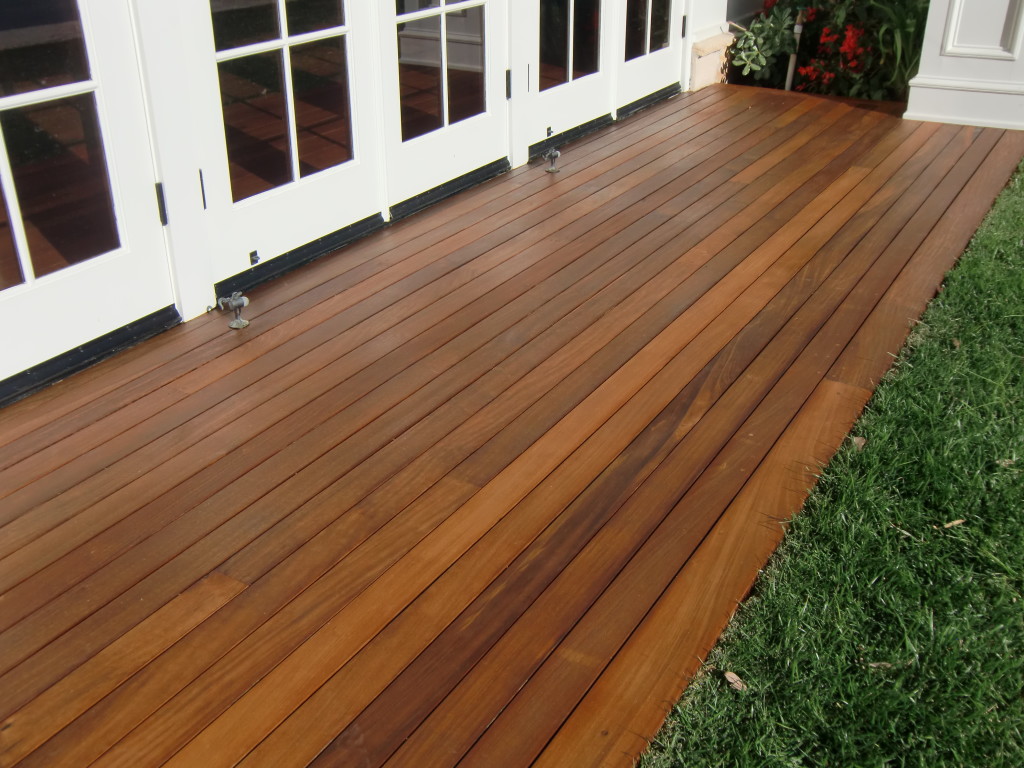Can You Use Teak Oil on Ipe Wood?
Ipe wood is a popular choice for decking, particularly in the warm, sunny climate of southern California, as it’s uniquely suited to combat moisture, salt air, and year-round threats from pests. One of the hardest and most durable decking materials on the market, it’s a great fit for any area, including high-traffic commercial spots. Ipe wood isn’t entirely maintenance-free, however. Understanding how to properly treat and clean this wood is a critical part of ipe care.
Properties of Ipe Wood
Ipe is a stunningly dense and durable hardwood. The wood fibers in ipe sit so close together that it takes 3,510 pounds of force just to scratch it. This same density makes ipe resistant to moisture, pests, and even fire. Native to the tropical Americas, ipe has a rich hue that ranges from reddish brown to a deep olive-brown that’s nearly black.
Ipe requires no protective treatment to maintain its strength and durability, offering decades of service even in high-traffic areas. However, untreated ipe will take on a silvery hue over time, which may not be ideal for the aesthetics of your space.
Teak Oil Uses
Teak oil is a wood finish that’s comprised of natural oils, UV inhibitors, varnish, and thinners. There’s no standard recipe for teak oil, so this product may contain a wide variety of ingredients in different proportions. Despite the name, teak oil is in no way derived from teak wood. Teak oil was not named for its ingredients, but rather for its intended use of treating teak wood.
Teak wood, like ipe, is a very durable and long-lasting product. However, there are some distinct differences. Teak’s strength is attributable to its oil content, which is so high that it simply can’t absorb much additional moisture. Though teak is still hard, with a Janka rating of 1,070 pounds, it doesn’t come close to the strength of ipe.
Teak oil is well suited to teak wood because it has a very thick consistency. It takes its time working into the dense, oily teak, resulting in a rich, warm color that rejuvenates the teak. Like ipe, teak grays over time, and teak oil can help restore the wood’s original appearance. It’s important to note, however, that teak oil only offers UV protection and a restorative solution to silvery weathering. It does not waterproof or otherwise protect your wood, and it must be reapplied once a year.
Suitability of Teak Oil for Ipe Wood
Though both teak and ipe need some form of UV protection to keep them from greying with age, teak oil is not the right product for ipe wood. The densely packed fibers of ipe wood don’t have adequate porosity to absorb teak oil. Even water will typically sit on the surface of natural ipe wood, rather than sinking in.
You need a specialized product that’s designed just for ipe if you want to penetrate a wood this dense. Teak oil or any other product not made specifically for ipe will just pool on the surface of the wood. Left to sit on the ipe this way, the oil will eventually darken, leaving unsightly black spots and stains on your otherwise beautiful deck.
Teak Oil vs. Ipe Oil
Like teak oil, ipe oil is named for the product that it’s designed to treat. Therefore, ipe oil is the superior option when you want a UV protectant for ipe wood. Ipe oil is deeply penetrating, which means that it’s formulated to sink into ipe wood despite its density.
Ipe oil’s primary purpose is to protect the wood from UV damage. It doesn’t waterproof the wood, but when you’re working with ipe it simply doesn’t need to. It will restore the rich natural color of ipe wood, but it’s not a stain. Therefore, it shouldn’t drastically change the wood’s original hue. For the most part, ipe oil simply works to keep the wood’s color from changing.
Alternative Treatments for Ipe Wood
Ipe oil is by far the best treatment for ipe, as it’s specially designed to overcome the distinct challenges of the wood and restore it to its full glory. If you’re looking for something to use instead of or along with ipe oil, there are a few other products that you can use, provided that these specify ipe on the label. They include:
- Oil-based stains: If you want to change the color of your ipe, you can use an oil-based stain that’s formulated for this type of wood. You’ll need plenty of patience, however, as even the best stains take a long time to soak into ipe.
- Penetrating hardwood oils: A penetrating hardwood oil can act as an effective protectant against UV rays and the associated fading. Ipe oil is the best, but some other oil blends can penetrate ipe as well.
- Wood brighteners: If your ipe is starting to fade, you may want to pre-treat it with a wood brightener before applying any type of oil or stain.
- Wood protectants: A specially formulated wood protectant or wood shield can help prevent any staining on the surface of the wood.
Maintenance and Care
Ipe wood is a very low-maintenance material, but it does still need regular care. A specialized wood cleaner is a great go-to for routine maintenance. While your ipe wood will repel moisture, rot, pests, and even most stains, it will still get dirty. A wood cleaner will help you scrub away surface messes, such as dirt and grime. Clean your deck every few weeks or whenever it’s noticeably dirty. If the deck is exposed to salty ocean air or muddy traffic, you may need to clean it more frequently.
Professional Ipe Restoration
If you haven’t diligently treated and maintained your ipe deck, you may need to invest in professional deck restoration services every few years. Our team at Teak Master has specialized products that are formulated specifically for ipe deck refinishing. Contact us for a quote on your project.

